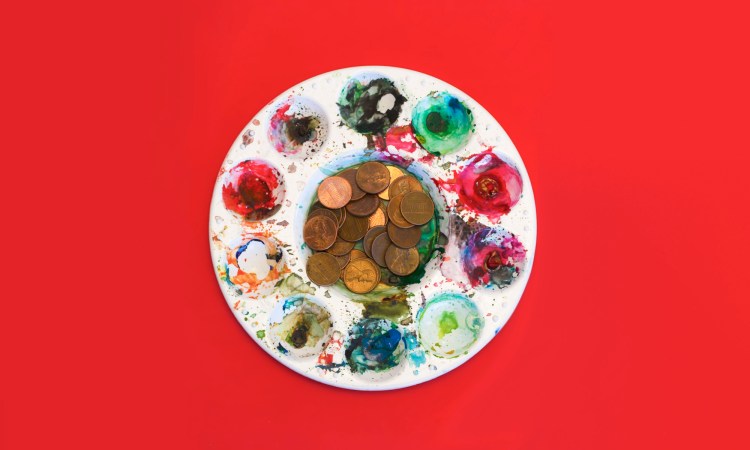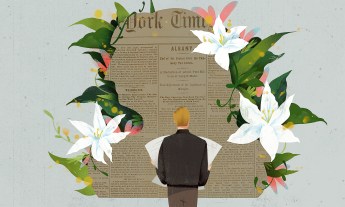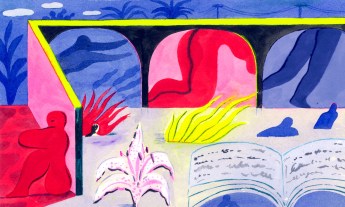
Only ten percent of art school graduates make a living from their artwork. Why should this be such a pipe dream?
I’ve had only two career goals in my life. The first was to go to Mars. I made it all the way to graduate school before realizing that I really preferred Earth, and also, that I loved writing more than science — more than anything, in fact.
So my second goal was to make a living solely from writing. Like with the first, I knew the goal was hard. I didn’t know it was almost as impossible.
This often comes as a shock to those who don’t work in the arts. Generally, they assume that if a writer is talented and works hard enough, she’ll get discovered and make a living for the rest of her life. But the data show this isn’t true. On the contrary, earning a steady living wage is the highest standard of economic success for a working artist in any field. And only a fraction of those who go to school to achieve that actually do, as one study demonstrated.
In the eleven years since I quit graduate school, I’ve worked mostly as a lab technician to support myself. During the day, I cleaned labs and ran assays. Every night, I wrote for three hours. On the weekends, I applied to hundreds of residencies, grants, fellowships, and literary journals — as chronicled in my anti-résumé — and got rejected, according to my math, 97% of the time. In my best year, I made $930 from my writing. But every year, my work expenses — application fees, residency fees, application postage, mailing supplies, art supplies, printing expenses, stationery, workspace rent, tickets, books, ebooks, website design fees, website hosting fees, conference registrations, travel expenses, and out-of-pocket health insurance — easily tallied $23,000 a year. In other words, my revenue covered 4% of my expenses, if I was lucky.
This changed a few years ago — briefly. In 2013, I sold my first novel, The Girl in the Road, to a major publisher. Given its unorthodox story — it’s about a bisexual Indian woman who walks across a floating bridge that spans the Arabian Sea — the fact that it sold at all was a miracle. Even more incredibly, the advance was enough to live on. I’d achieved the highest standard. I’d won the game.
Until that money ran out. Which is where I am now.
Again, this surprises those who don’t work in creative fields. They assume writers live on royalties. But even if a writer earns royalties above and beyond their advance, they’re rarely enough to live on. There’s nothing to do but write the next novel, with no guarantee of a sale. That’s often the case even when a first novel satisfies a publisher’s sales expectations. And even though The Girl in the Road was critically adored, awarded a major literary prize, beloved by a tribe of new fans and praised by excellent writers like Neil Gaiman and Kim Stanley Robinson — a bestseller it was not.
Under the current economic models, even when writers win, they lose.
Literature, like almost all creative fields spooked by the 2008 economic crash and the rise of new technologies, has increasingly built a model that centers on Big Things. The breakout album, the solo exhibition, the feature film, the debut novel. They’re one-time gambles for both the artist and the producer. If the gamble pays off, the artist gets another chance. If it doesn’t, the producer often looks for another artist.
In other words, I ended up in much the same situation as I started. There was nothing to do but keep working on the next book.
In 2015, I worked continuously, year-round, on a new novel set in Central America. Every day, I got up, wrote for two hours, answered emails, went back to writing for six hours, worked out at the gym, relaxed with a book or TV and then went to bed. I also taught myself Spanish, exhaustively researched the ancient Maya, and traveled to Belize for fieldwork.
My entire intake for that year was about $7,000. That was from a few essays and a brief teaching gig. Meanwhile, I went $20,000 into debt, just from day-to-day expenses while I worked on the novel. Now, I’m hoping that my next novel will sell and “rescue” me, but in truth, I have no guarantee of that.
I don’t want pity. I’m saying this to illustrate that, under the current economic models, even when writers win, they lose. About a year ago, I realized this, and resolved three things: (1) that my work had profound value and deserved monetary compensation, (2) that I could not trust the existing economic models to give me that compensation, and (3) I had to find new ones.
Artists should stop trying to win the game, and start trying to change the game.
I’m not alone in these goals. The art world has a host of activists working to better the intersection of art, labor and value. But I’ve become increasingly frustrated with activism that focuses on trying to make gatekeepers aware of problems, such as low or nonexistent pay, or gender, color and class biases. Institutions and corporations have no real incentive to solve or even acknowledge these problems. They prioritize their own economic survival over that of artists, and, in my experience respond to stress by becoming more risk-averse, not less.
I’d rather find — or invent — new economic models that place artists first.
The best I’ve found so far is Patreon, a relatively new platform that tries to reinvent the ancient model of sustained arts patronage. If Kickstarter is a one-night stand, Patreon is going steady, opening a direct, ongoing dialogue between an artist and her patrons. I already had a relationship with a core group of fans because of The Girl in the Road and a kerfuffle with Wired, so it was enough to get started. I don’t yet make a living wage, but that’s my goal. I’m getting there. My Patreon salary covered my rent while I was writing, memorizing and rehearsing my TED talk. In return, my patrons got the story exclusively, months before anyone else set eyes on it.
I’m not naive — I know that no one model will fit all artists. Patreon, for example, favors prolific artists who already have a following and who thrive on a close relationship with fans. What I want to emphasize is that artists should stop trying to win the game, and start trying to change the game. After all, artists innovate — it’s what we do, no matter what our medium is. We imagine ways forward that no one else has imagined before, in literature, music, theater, dance, art, performance. There’s no reason we can’t do it with economics as well.
Art isn’t some incidental decoration on culture. It is culture. But there is no art without artists, and there are no artists without compensation. Quid pro quo. It’s as simple as that.













